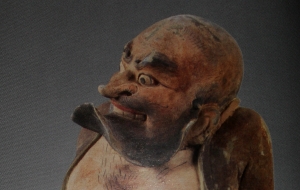The irony of the T’ang
Published on 07 April 2012
Updated on 05 April 2024
Updated on 05 April 2024
Western art did not take easily to realism, irony, and caricature. Greek and Roman art was set mainly in the heroic and hieratic mode. Paintings of private homes of Pompeii and Herculaneum at times suggest the grotesque and numinous. Irony was but a hint – if at all. Take the T’ang, the “premier” dynasty of China (618 – 907 AD). Realism and irony were part of the canon[1] – I’ say they defined it. Let’s look at figurines like this one:
Or this character: These figurines represent “foreigners”. Their realism also conveys “foreignness” – a sense of amused and superior distance on the part of the owner (the artist may well have been a foreigner). Or is it slight envy? Who knows? Heian Japan, quite close to China at the time, also has much realist and some ironic art, including the first cartoon ever made https://www.tnm.jp/modules/r_collection/index.php?controller=dtl&colid=A8&t=type&id=11. The “origins” of these representations might go back to Buddhism. The fundamentally Universalist message of Buddhism was that anyone could enter nirvana. How better to signify the message than through the infinite diversity of the human expressions, including – nay especially – foreigners? At a time when Charlemagne was smiting so many Saxon pagans that the Pope Adrian I[2], at loss for souls to proselytize, deemed his deeds “misguided zeal”, the T’ang were making of the “foreign” a signet element of their art. Irony, humor and caricature are backhandedly inclusive. They provoke laughter, not derision. And laughter is the greatest solvent of division[3] and alterity. Lore has it that Napoleon, considering a young and capable general for promotion, inquired: “Yes, yes I know he’s brilliant, but is he lucky”? I’d ask of any diplomat to be put in charge of a negotiation: “yes, but has he (self-) irony and a sense of humor?”
[1] See: Chao-Hui Jenny LIU (2008): Horses and beauties: mural art from Tang imperial tombs. In: Sabrina RASTELLI (Ed.) (2008): China. At the court of the emperors. Unknown masterpieces from Han tradition to Tang elegance (25 – 907). SKIRA, Milan.
[2] David Levering LEWIS (2008): God’s crucible. Islam and the making of Europe, 570 – 1215. Norton, New York.
[3] Arthur KOESTLER (1964): The act of creation. Penguin, Harmondsworth.



Leave a Reply
Want to join the discussion?Feel free to contribute!